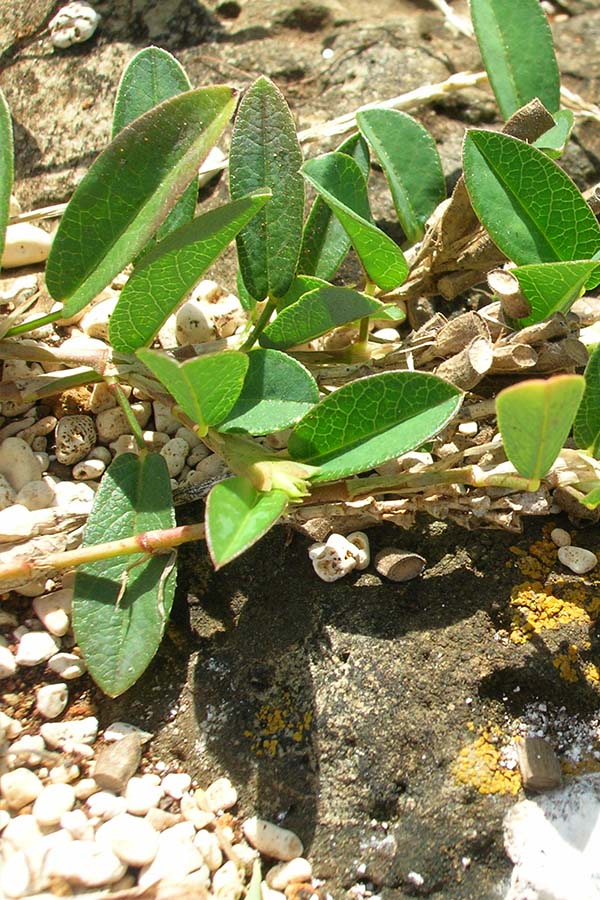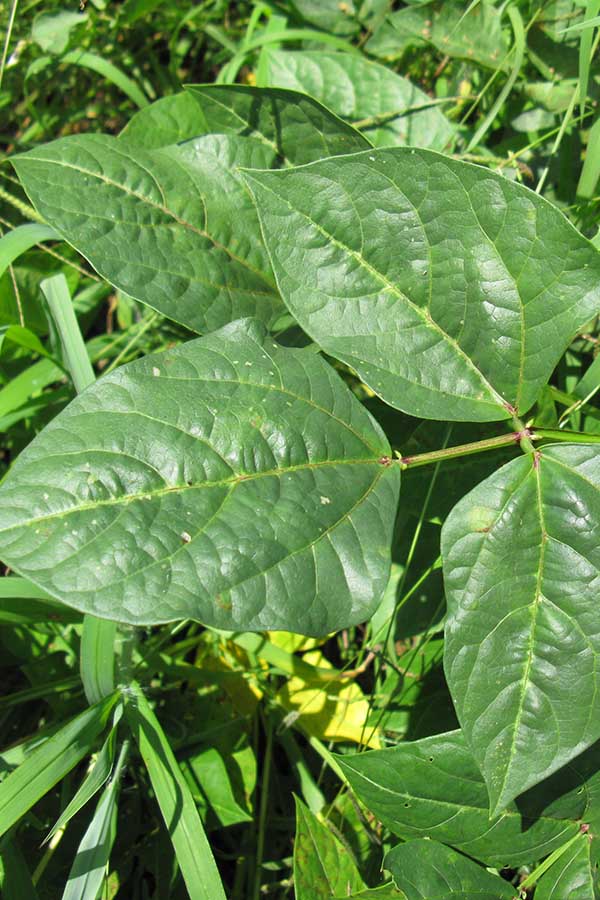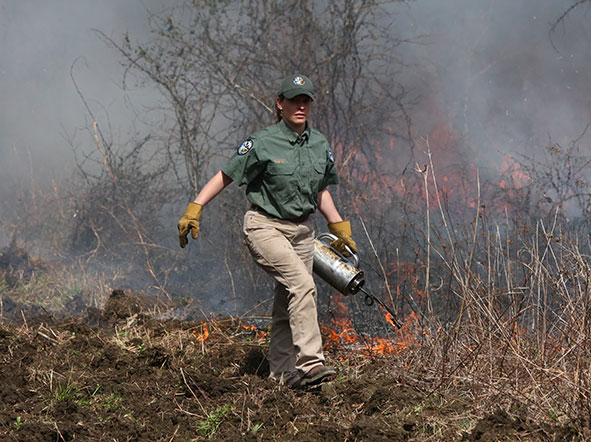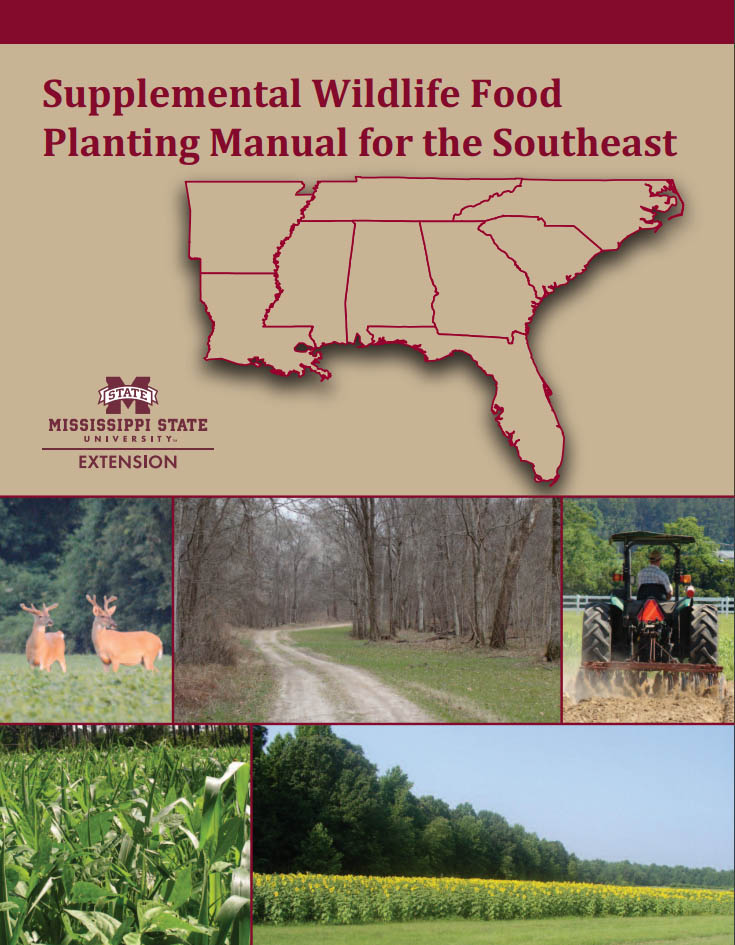Warm Season Plants

Alyce Clover

Cowpeas

Deer Vetch

Soybeans
Legumes (remember to inoculate legumes with bacterium)

Cowpeas (Vigna unguiculata)
- Description: A warm-season annual legume browsed by deer and rabbits. Seeds are highly used by quail and turkey but rarely eaten by dove.
- Soil Adaptation: Adapted to well-trained soils, from sandy loams to heavy soils.
- Planting Dates: May 1 through July 1
- Soil pH Range: 5.2 to 7.5
- Fertilization: Apply fertilizer according to soil test recommendations, or apply 150 lbs/ac of 0-20-20 before planting, and disk into the seedbed.
- Soil Preparation: Plant in a well-prepared, firm seedbed.
- Planting Rates: Drill 15 lbs/ac in 24 to 36-inch wide rows; broadcast 45 lbs/ac. Cover seeds 1/2 to 1 inch deep.
- Varieties: Iron Clay, Red Ripper, Combine
- Inoculant Strain: EL
- Companion Plants: Egyptian wheat, grain sorghum, corn, other warm-season annual peas.
- Management: Large plots may be required in areas of high deer density. If seed is not consumed, disking in April can encourage reseeding.
- Recommended Herbicides: A preemergence application of Pursuit (4-fl. oz/ac) or Prowl 3.3 EC (1 to 3 pts/ac) will control many warm-season annual weeds. Use a postemergence application of Select (10-fl. oz/ac) or Poast Plus (2 to 3 pts/ac) to control grass weeds. Where sicklepod is a problem, we recommend a postemergence application of either Frontrow (0.4-fl. oz/ac), Blazer (2 pts/ac), or Butyrac 200 (2 pts/ac). You can also use an early postemergence application of Pursuit to control grass weeds.

Deer Vetch (Aeschynomene americana)
- Description: A warm-season annual, reseeding legume growing to 6 feet tall. The foliage is highly palatable and withstands heavy grazing pressure by deer. AESCHYNOMENE CAN BECOME INVASIVE WHEN PLANTED NEAR WATERFOWL IMPOUNDMENTS OR RICE FIELDS.
- Soil Adaptation: Adapted to a wide range of soil types; light-textured soils and dry upland sites, including well-drained sandy soils. Also grows on poorly drained, most soils.
- Planting Dates: March 15 through June 15
- Soil pH Range: 5.0 to 6.5
- Fertilization: Apply fertilizer according to soil test recommendations
- Soil Preparation: Plant in a well-prepared, firm seedbed.
- Planting Rates: Drill 15 lbs/ac; broadcast 20 lbs/ac. Cover seeds 1/4 to 1/2 inch deep.
- Varieties: Lee, Glenn
- Inoculant Strain: EL
- Companion Plants: Alyceclover
- Management: Depending on grazing pressure, reseeding may be enhanced by early spring mowing and disking. Reapply 100 lbs/ac of 0-20-20 yearly or as needed in the fall.
- Recommended Herbicides: A preemerge application of Pursuit (4-fl. oz/ac) or Prowl 3.3 EC (1 to 3 pts/ac) will control many warm-season annual weeds. Use a postemergence application of Select (10-fl. oz/ac) or Poast Plus (2 to 3 pts/ac) to control grass weeds. You can also use an early postemergence application of Pursuit to control grass weeds.

Soybeans (Glycine max)
- Description: A warm-season annual legume. Provides excellent forage for deer and seeds for dove, quail, and turkey.
- Soil Adaptation: Adapted to most soil types and conditions.
- Planting Dates: April 15 through June 1
- Soil pH Range: 5.5 to 7.0
- Fertilization: Apply fertilizer according to soil test recommendations, or apply 50 lbs/ac of 0-46-0 and 50 lbs/ac of 0-0-60 at time of planting.
- Soil Preparation: Plant in a well-prepared, firm seedbed.
- Planting Rates: Drill 30 lbs/ac in 32 to 46 inch wide rows; broadcast 60 lbs/ac. Cover seeds 1/2 to 1 inch deep.
- Varieties: Commercial varieties, Hutchinson, Tyrone, Large Ladd
- Inoculant Strain: S
- Companion Plants: Corn, Egyptian wheat, and grain sorghum.
- Management: Large plots may be required in areas of high deer density and you may have to prevent grazing for the first month following germination to allow plots to become established.
- Recommended Herbicides: Roundup Ready systems are recommended; use a preemergence application of Pursuit (4-fl. oz/ac) or Prowl 3.3 EC (1 to 3 pts/ac) to control many warm-season annual weeds. Use a postemergence application of Select (10-fl. oz/ac) or Poast Plus (2 to 3 pts/ac) to control grass weeds. Where sicklepod is a problem, we recommend a postemergence application of either Frontrow (0.4-fl. oz/ac), Blazer (2 pts/ac), or Butyrac 200 (2 pts/ac). You can also use an early postemergence application of Pursuit to control grass weeds.

Alyceclover (Alysicarpus vaginalis)
- Description: A warm-season annual legume that provides forage in summer and early fall. Especially important to white-tailed deer; holds up well to grazing pressure.
- Soil Adaptation: Suited to most moderate to well-drained soils, including bottomland sites.
- Planting Dates: May 1 through June 15
- Soil pH Range: 5.5 to 7.0
- Fertilization: Apply fertilizer according to soil test recommendations, or apply 100 lbs/ac of 0-46-0 and 50 lbs/ac 0-0-60 postemergence (once stand is established).
- Soil Preparation: Plant in a well-prepared, firm seedbed.
- Planting Rates: Drill 15 lbs/ac; broadcast 20 lbs/ac. Cover seeds 1/2 inch deep.
- Varieties: NA
- Inoculant Strain: EL
- Companion Plants: Plant with forage cowpeas and/or joint vetch.
- Management: Mowing and/or disking in late October may help reseeding. Apply 100 lbs/ac of 0-46-0 the following May.
- Recommended Herbicides: A preemergence application of Pursuit (4-fl. oz/ac) or Prowl 3.3 EC (1 to 3 pts/ac) will control many warm-season annual weeds. Use a postemergence application of Select (10-fl. oz/ac) or Poast Plus (2 to 3 pts/ac) to control grass weeds. You can also use an early postemergence application of Pursuit to control grass weeds.

Lablab (Lablab purpureus)
- Description: A very drought-tolerant, fast growing, erect, warm-season legume that is weakly perennial and does not readily reseed. Highly preferred by deer. Used widely in south Texas.
- Soil Adaptation: Grows on well-drained, sandy, upland sites; does not tolerate wet soils.
- Planting Dates: April 1 through June 1
- Soil pH Range: 5.5 to 7.5
- Fertilization: Apply fertilizer according to soil test recommendations, or apply 150 lbs/ac of 0-20-20 before planting and disk into the seedbed.
- Soil Preparation: Plant in a well-prepared, firm seedbed.
- Planting Rates: Drill 5 lbs/ac; broadcast 10 lbs/ac. Cover seeds 1 inch deep.
- Varieties: Rongai, Highworth, Rio Verde
- Inoculant Strain: EL
- Companion Plants: Alyceclover, millet, corn, and grain sorghum.
- Management: Seedings are not competitive; keep seedbed free of weeds. In areas of high deer density, you may have to prevent grazing for the first month following germination to allow establishment. Reseed each year.
- Recommended Herbicides: A preemergence application of Pursuit (4-fl. oz/ac) or Prowl 3.3 EC (1 to 3 pts/ac) wil control many warm-season annual weeds. Use a postemergence application of Select (10-fl. oz/ac) or Poast Plus (2 to 3 pts/ac) to control grass weeds. Where sicklepod is a problem, we recommend a postemergence application of either Frontrow (0.4-fl. oz/ac), Blazer (2 pts/ac), or Butyrac 200 (2 pts/ac). You can also use an early postemergence application of Pursuit to control grass weeds.

Forage Soybeans (Glycine spp.)
- Description: A trailing/climbing, warm-season, annual legume. Provides excellent forage for deer and rabbits and seeds for quail and turkey.
- Soil Adaptation: Adapted to most soil types and conditions.
- Planting Dates: April 15 through June 15
- Soil pH Range: 5.5 to 7.0
- Fertilization: Apply fertilizer according to soil test recommendations, or apply 50 lbs/ac of 0-46-0 and 50 lbs/ac of 0-060 at time of planting.
- Soil Preparation: Plant in a well-prepared, firm seedbed.
- Planting Rates: Drill 10 lbs/ac in 32 to 46 inch wide rows; broadcast 25 lbs/ac. Cover seeds 1/2 to 1 inch deep.
- Varieties: Laredo, Quail Haven, White-tail Thicket
- Inoculant Strain: S
- Companion Plants: Corn, Egyptian wheat, grain sorghum
- Management: In areas of high deer density, you may have to prevent grazing for the first 30 to 60 days after germination to allow plots to become established. Works well in seed mixtures with corn, Egyptian wheat, and grain sorghum; the vines climb the stalks. May resser naturally if disked in early spring. High deer populations may result in little or no reseeding of stand.
- Recommended Herbicides: Roundup Ready systems are recommended; use a preemergence application of Pursuit (4-fl. oz/ac) or Prowl 3.3 EC (1 to 3 pts/ac) to control many warm-season annual weeds. Use a postemergence application of Select (10-fl. oz/ac) or Poast Plus (2 to 3 pts/ac) to control grass weeds. Where sicklepod is a problem, we recommend a postemergence application of either Frontrow (0.4-fl. oz/ac), Blazer (2 pts/ac), or Butyrac 200 (2 pts/ac). You can also use an early postemergence application of Pursuit to control grass weeds.
Other

Corn (Zea mays)
- Description: A warm-season annual grain, high in carbohydrates (provides energy); highly favored by wildlife.
- Soil Adaptation: Widely adapted; performs best on sites with well-drained, highly fertile soils.
- Planting Dates: March 15 through June 1
- Soil pH Range: 5.8 to 7.0
- Fertilization: Apply fertilizer according to soil test recommendations, or apply 200 lbs/ac of 0-20-20 at time of planting and 450 lbs/ac of 34-0-0. Apply half the rate of 34-0-0 at time of planting, and side dress with the other half 20 to 30 days postemergence.
- Soil Preparation: Plant in a well-prepared, firm seedbed.
- Planting Rates: Drill 12 lbs/ac in 30 to 40 inch wide rows; broadcast 15 lbs/ac. Cover seeds 1 inch deep. BROADCAST PLANTING IS NOT RECOMMENDED FOR THIS CROP.
- Varieties: Commercial varieties, Dwarf Tropical (those that produce low-growing "ears" are best for wildlife).
- Companion Plants: Cowpeas, lablab, soybeans (commercial and/or wildlife).
- Management: IF PLANTING TO ATTRACT WATERFOWL, YOU CANNOT MECHANICALLY MANIPULATE PLANTED CROPS IN THE SAME YEAR OF PLANTING. You can plant Japanese millet and cereal grains together to provide height/diet diversity. If managing for doves, mow in alternating strips, starting about 2 weeks before the season. For deer, rabbit, quail and turkey, leave stalks standing throughout the dormant season and allow grain to fall naturally. If drilled, plantings of cowpeas, soybeans, or lablab between rows provide high protein deer forage during mid to late summer; and lush foliage attracts insects and provides good "bugging" areas for quail and turkeys.
- Recommended Herbicides: For conventional cropping systems where you want to attract waterfowl, a preemergence application of a tank mix glyphosate herbicide (2 pts/ac) and Atrazine (4 pts/ac) allows desirable grass weeds to persist after corn is established. Where you want to attract wildlife other than waterfowl, we recommend a Roundup Ready cropping system. In a conventional cropping system we recommend a preemergence application of a tank mix of Atrazine (4 pts/ac). When planting warm-season legumes with corn, use a preemergence application of Dual II or Prowl 3.3 EC (2 to 4 pts/ac).

Buckwheat (Fagopyrum esculentum)
- Description: A warm-season annual grain. Deer, rabbits, and turkeys eat the foliage and drove, quail, turkey, and songbirds eat the seed.
- Soil Adaptation: Widely adapted to fertile and infertile soils. Grows best on well-drained sites.
- Planting Dates: May 1 to June 1
- Soil pH Range: 6.0 to 7.0
- Fertilization: Apply fertilizer according to soil test recommendations, or apply 100 lbs/ac of 0-20-20 and 150 lbs/ac of 34-0-0 once stand is established.
- Soil Preparation: Plant in a well-prepared, firm seedbed.
- Planting Rates: Drill 40 lbs/ac; broadcast 60 lbs/ac. Cover seeds 1/4 to 1/2 inch deep.
- Varieties: Japanese, Silverhull, Common Gray, Mancan, Manor, Royal, Tokyo
- Companion Plants: Sunflower, millets, and grain sorghum.
- Management: Can mature quickly (65 to 85) days, and seed production is hurt by high temperatures, so early planting is best. Lodging is common.
- Recommended Herbicides: None Recommended
Supplemental Wildlife Food Planting Manual for the Southeast
For more information about these plants including seeding rates, legume inoculants, and herbicide and fertilizer recommendations, please follow this link to the publication Supplemental Wildlife Food Planting Manual for the Southeast.




